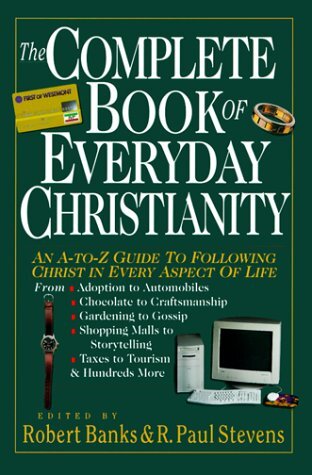Art
Book / Produced by partner of TOW
For the Christian all of life is meant to glorify God. This fact has been used both to encourage and to discourage the use of art by Christians. Historically, of course, Christianity (and religion in general) has provided the most important motivation and sources for the development of art.
The Church and Art
After the conversion of Constantine in 312, the church became the primary patron of the arts, especially in the building and decorating of churches. During the Middle Ages, in addition to architecture, drama, sculpture, music and painting were all developed vigorously for purposes of worship and instruction. Painting in particular was stimulated by an important change in the church’s liturgy. In the thirteenth century the priest began to face the congregation as he performed the Eucharist. This necessitated moving the table forward from the back wall of the sanctuary, thus leaving an empty space that soon was filled with beautiful altar pieces. Drama as we know it today likewise had its birth in medieval morality plays that acted out various parts of the gospel for the people, who were mostly unable to read Scripture for themselves. In the case of music it is difficult to imagine any form of Christian life and worship in which this does not play a central role (see Music, Christian). As we will see, music goes back to the biblical period, but it was given special impetus by the medieval Gregorian chants and the Reformation chorales.
The desire to glorify God with the whole of one’s life also served to discourage the development of certain kinds of art. At the Reformation, for example, John Calvin was convinced that the use of images (in both painting and sculpture) had begun to distract people from hearing the truth of God’s Word and tended to become idolatrous. As a result the Reformed tradition has often focused on the verbal arts of music and drama, rather than the visual arts, as safer vehicles for communicating the gospel. Meanwhile the Catholic tradition, with its emphasis on the visual drama of the Eucharist and its sacramental view of reality, has continued to place a high value on the visual arts.
As society gradually became more secular and the influence of the church and Christianity declined, the connection between art and Christianity was lost. By the end of the nineteenth century most leading artists prided themselves on their independence, not only from Christianity but from any mythological framework. Art became a medium for the expression of a personal vision rather than the means of communicating common values. And since most artists were raised without any Christian influence, what they expressed was not only antagonistic to Christianity but often alarming to Christians.
It is not surprising that at the beginning of the twentieth century Christians looked at the arts more as a field for evangelism than as an ally in expressing and living out their faith. Becoming an artist was not considered to be a viable option for the serious Christian, and those Christians who did manage to go to art schools encountered an environment that was not encouraging to their faith. The result is that outside of music (mostly classical or Christian) and an occasional drama, Christians do not typically give much thought to the arts in their everyday life.
Biblical Perspectives on Art
In support of this negative attitude, Christians typically point out how little emphasis the Bible gives to the arts. The Old Testament appears to forbid the making of graven images, and the New Testament obviously has more important things on its mind.
Like the Reformation, the Old Testament seems clearly to favor music and poetry over the visual arts. Beauty was surely included when God judged the work of creation to be very good, but at the Fall the devil was able to use this very beauty to tempt Adam and Eve to doubt God’s word (Genesis 3:6). The prohibition against graven images in the Ten Commandments probably had more to do with the temptation to idolatry than with the fear of images as such. In support of this view, notice the careful and detailed instructions given for building the tabernacle and temple as places where beauty is brought into the service of worship (Exodus 31). In this respect God’s people seemed almost profligate in their use of art. The temple used materials and motifs from all over the ancient world, and Psalms and Proverbs actually embody poetic forms to praise Israel’s God that were used elsewhere in the ancient Near East. So while nothing, not even beauty, should be allowed to share the honor due God, all the works of human hands (and hearts) could be employed to promote that honor.
In the New Testament Paul’s reaction to the classical beauty and paganism of Athens is perfectly consistent with this reading of things (Acts 17). When he rose to speak on Mars Hill, he could easily see the splendid frieze of the Parthenon (known to us as the “Elgin Marbles” in the British Museum); there too was the Temple of the Wingless Victory and the vast statue of Athena Promachus. Like the prophets before him, “his spirit was provoked within him as he saw that the city was full of idols” (Acts 17:16 RSV). Was this his only reaction to such splendor? That Paul was no philistine is clear from his quoting no fewer than two Greek poets in that same Mars Hill sermon. No, he was not insensitive to beauty, but he saw that art taken out of the service of God could become a snare and that God’s kingdom mattered more than humankind’s achievement—even in the realm of beauty. The error of pagan artists was not their view of art but their view of God, though the former showed the latter as surely as water flows downward.
Likewise the thronelike altar to Zeus on the acropolis of Pergamum moved God to say through the apostle John to the church at Pergamum, “I know where you dwell, where Satan’s throne is” (Rev. 2:13 RSV). So John could rightly urge: “Little children, keep yourself from idols” (1 John 5:21). It would be as much a mistake to read all of this as an absolute denunciation of art as it would be to see Christ’s statement about hating one’s father and mother (Luke 14:26) as a denunciation of the family. Rather, we are seeing a biblical vision of a higher order of things in which both family and art should find their right and lovely place—an order in which all things find their relation to God, who in Christ is calling out a people for his name.
But like Ezekiel and Isaiah, the New Testament not only contains warnings about the false use of imagination but draws on imagery throughout the Bible and puts it in the service of its view of the last things in the book of Revelation. In our concentration on the literal meaning of that book, we often overlook the more immediate emotional impact of these images.
Art in Everyday Life
All of this suggests that the use of the arts in our ordinary life should not be treated lightly. On the one hand, we need to understand the ways in which beauty and aesthetic forms generally move us. Beauty can seduce us to evil, as David learned, but ugliness can also tempt us to turn away from human need. So we cannot ignore the working of art and music in our lives, even if they have not figured prominently in our Christian conversation and training. Popular music, movies and television are important parts of the modern environment in which aesthetic forms are put in the service of worldviews that may conflict with or sometimes support Christian values. If we believe that all of life is to be brought under the lordship of Christ, we must learn to develop a Christian discernment in our use of contemporary media, for one way or another it will influence us.
On the other hand, we can positively seek to make even ordinary events of our lives into vehicles for honoring Christ. If God has given particular talents in the arts, these need to be developed and put in God’s service—whether in the church or in the larger world of culture. But even if we do not feel a particular call or interest in the fine arts, we can still seek to make our lives into vehicles for God’s own beauty. As well as our treating people with dignity and respect, this involves making our homes places where family and visitors can relax and know something of the peace and loveliness that God’s reconciling grace has brought into our lives. The biblical record clearly implies that salvation will have a visual and aesthetic dimension as the Holy Spirit manifests God’s grace throughout the fabric of our lives together—in our meals, conversations around the fire and the flowers we place around.
Art and Spirituality: Glimmers of the Heavenly Kingdom
Art and beauty are important not only as nice additions to our lives but because there is a close relationship between the experience of these things and our worship of God, that is, between art and spirituality. While our chief calling is to love God with all we are, art can train our sensitivity to people’s pain and joy, both of which Scripture mandates. It can move us to a more profound praise of God and a deeper understanding of God’s work in our lives, as our experience of a Bach chorale or a lovely Communion service testifies. Exposure to and involvement with great art make us better able to feel the heights and depths of human experience and so to become agents of God’s love in a broken world. For all these reasons it is no accident that the connection between art and worship has been so strong throughout the history of God’s people.
There is another reason why art should play a central role in our lives as Christians. The imagery of the book of Revelation pictures the heavenly kingdom in terms of a great chorus or, better still, a great opera in which God and the redeemed from all the ages are involved. Rev. 5:11-14 and Rev. 6:9-10 picture people from every tongue and nation gathered around God’s throne singing (and shouting) praise to God for the Lamb that was slain. It is no accident that the culmination of all history is described in terms of a great religious drama filled with both music and visual imagery. All of this gives us ample grounds for featuring arts prominently in our present lives. In fact, we might be justified in seeing all we do as a kind of grand rehearsal for that heavenly chorus. If the forms of art and music will honor God throughout all eternity, they can certainly be used now to point people to the source of all that is good and beautiful. Our goal should be to write over the whole of our lives the words that J. S. Bach put over each of his chorales: soli Deo gloria—“to the glory of God.”
» See also: Architecture, Urban
» See also: Beauty
» See also: Imagination
» See also: Music
» See also: Music, Christian
» See also: Vision
» See also: Worship
References and Resources
D. Apostolos-Cappadona, ed., Art, Creativity and the Sacred (New York: Crossroad, 1984); J. S. Begbie, Voicing Creation’s Praise (Edinburgh: T & T Clark, 1991); J. Dillenberger, Style and Content in Christian Art (New York: Abingdon, 1965); F. Gaebelein, The Christian, the Arts and Truth (Portland, Ore.: Multmomah, 1985); H. Rookmaaker, The Creative Gift: Essays on Art and the Christian Life (Weschester, Ill.: Cornerstone Books, 1981); E. Schaeffer, The Art of Life (Wheaton, Ill.: Good News Publishing, 1987).
—William Dyrness





